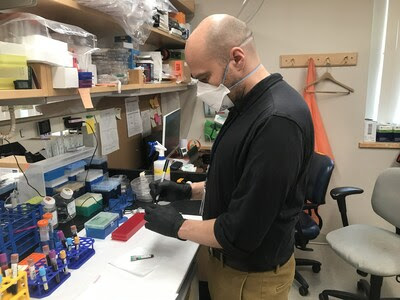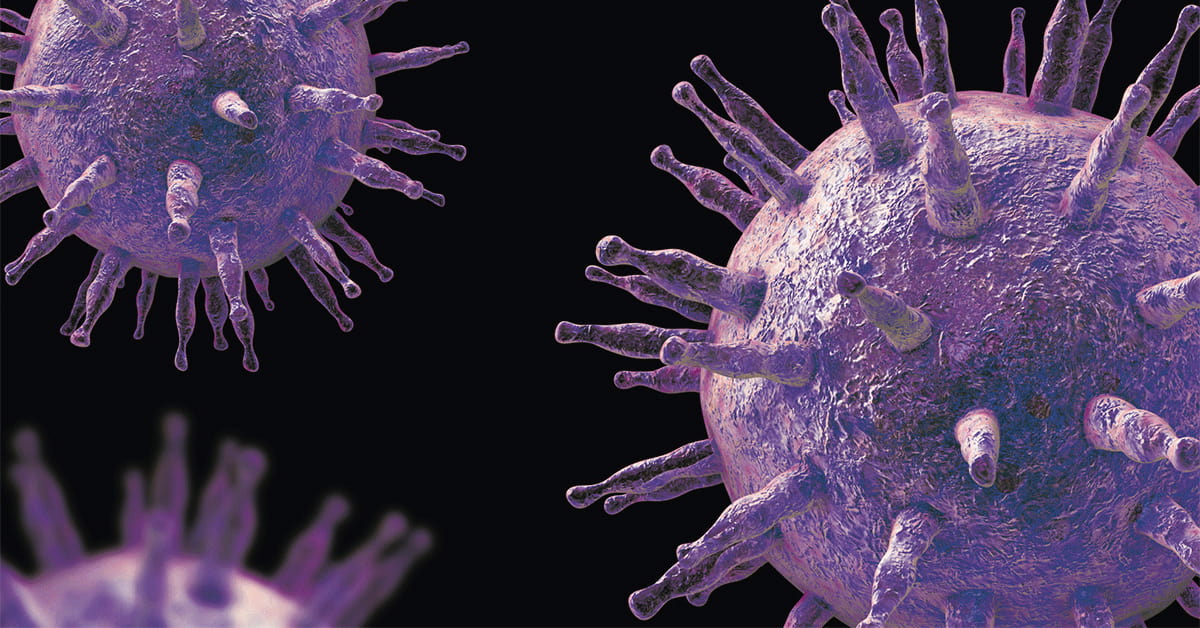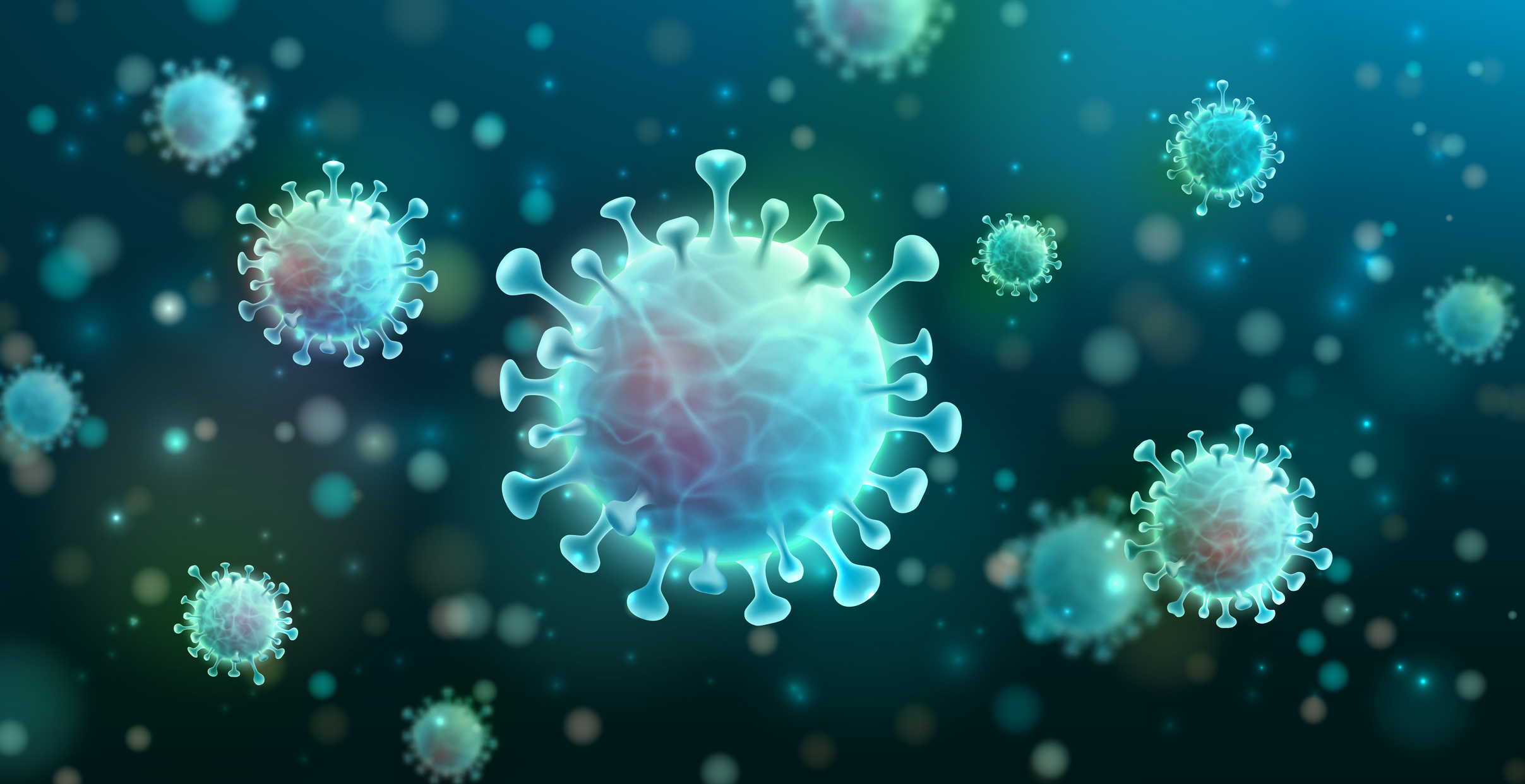Recent research reveals the potential of Traditional Chinese Medicine (TCM) in combating African Swine Fever (ASF), a viral disease with near 100% mortality rate in pigs. The study explores TCM’s antiviral properties and its role in enhancing immunity, offering a novel strategy in the face of limited effective treatments.
Tag: Virus
Bacterial proteins shed light on antiviral immunity
A unique collaboration between two UT Southwestern Medical Center labs – one that studies bacteria and another that studies viruses – has identified two immune proteins that appear key to fighting infections.
Plant virus treatment shows promise in fighting metastatic cancers in mice
An experimental treatment made from a plant virus is effective at protecting against a broad range of metastatic cancers in mice, shows a new study from the University of California San Diego.
ADLM releases guidance to help healthcare professionals navigate respiratory virus testing in a post-COVID world
The Association for Diagnostics & Laboratory Medicine (ADLM, formerly AACC) has issued a new guidance document that provides expert recommendations on fundamental areas of clinical testing for respiratory viral infections. As respiratory virus testing continues to evolve rapidly in the wake of the COVID-19 pandemic, this guidance aims to ensure that patients benefit fully from emerging technologies in this field.
1 in 5 milk samples from grocery stores test positive for bird flu. Why the FDA says it’s still safe to drink
The FDA announced 1 in 5 grocery store milk samples tested positive for bird flu. UC Davis experts explain the limits of the test and how to protect yourself from avian influenza.
Scientists discover higher levels of CO2 increase survival of viruses in the air and transmission risk
A new study has revealed for the first time the vital role carbon dioxide (CO2) plays in determining the lifespan of airborne viruses – namely SARS-CoV-2, the virus that causes COVID-19. It clearly showed keeping CO2 levels in check helps to reduce virus survival, and therefore the risk of infection.
More Than 100 Kids Have Died of Flu This Year
Maria Ruiz, is an associate professor of medicine and an infectious disease expert at the GW School of Medicine and Health Sciences. She can discuss how the flu can react differently in children and the best forms of protection. Amita…
Norovirus Spreading in the Northeast
Michael Knight is an assistant professor of medicine at the George Washington University School of Medicine and Health Sciences. He can discuss the virus, how to protect yourself and the best treatments. Jose Lucar is an associate professor of infectious…
‘Dynamic duo’ defenses in bacteria ward off viral threats
Scientists at the University of Southampton have discovered that bacteria can pair up their defense systems to create a formidable force, greater than the sum of its parts, to fight off attack from phage viruses.

New LongCOVID research launched by PolyBio’s global consortium of scientists
PolyBio Research Foundation today announced the second phase of its LongCovid Research Consortium (LCRC), including the distribution of $15M to fund research and clinical trials.
UC Irvine-led research team creates novel rabies viral vectors for neural circuit mapping
Irvine, Calif., Feb. 14, 2024 — A research team led by the University of California, Irvine has created 20 new recombinant rabies viral vectors for neural circuit mapping that offer a range of significant advantages over existing tools, including the ability to detect microstructural changes in models of aging and Alzheimer’s disease brain neurons.
Interactions between flu subtypes predict epidemic severity more than virus evolution
Researchers have shed new light on how viral evolution, population immunity, and the co-circulation of other flu viruses shape seasonal flu epidemics.
Rutgers Awarded NIH Grant to Study How Previous Infections Affect Immune Response to Lung Disease
Researchers will examine how the body’s adaptations to viruses, fungi and parasites change its ability to combat unrelated respiratory infections.

Virginia Tech’s Linsey Marr named 2023 MacArthur Fellow
Linsey Marr, the Charles P. Lunsford Professor and a University Distinguished Professor at Virginia Tech, has been named a 2023 MacArthur Fellow, a highly prestigious award commonly called a “genius grant.” The John D. and Catherine T. MacArthur Foundation announced Wednesday that Marr is one of 20 fellows who will receive an $800,000 award.

Not all viruses are harmful
During the COVID-19 pandemic, people became well aware that viruses can be extremely harmful. But can viruses also be helpful? Bryan Hsu aims to find out by studying viruses that infect bacteria in the bellies of mammals.
Atopic dermatitis: Viruses discovered as new therapy option
Up to 15 percent of children and five percent of adults are affected by the chronic inflammatory skin disease atopic dermatitis. Despite advanced therapy measures, the severe itching and eczema, especially on the elbows or knees, cause great distress to the patients.
Reductions in sexual mixing ended mpox outbreak in England, while vaccination has prevented resurgences in 2023
The rapid outbreak of mpox (formerly known as monkeypox) in 2022 likely resulted from high levels of sexual mixing among some gay, bisexual and other men who have sex with men (GBMSM), with the initial downturn in cases probably due to a reduction in sexual contacts among these men.

Viral evolution expert available for comment on new BA.2.86 COVID variant
URBANA, Ill. — Last week’s classification of BA.2.86 as a COVID “variant under monitoring” by the World Health Organization raises many epidemiological and public health questions. Among the unknowns is how the virus evolved to acquire 36 to 38 mutations…
Dr. Jaime Avila shares back-to-school tips that parents should know.
Jaime Avila, MD, at Baylor Scott & White McLane Children’s Medical Center, answers common patient questions and reacts to the latest medical research What can parents do to help ease back-to-school anxiety? (SOT@ :14, TRT :51) Some kids may not…
A new look inside Ebola’s “viral factories”
The study, led by scientists at La Jolla Institute for Immunology (LJI), reveals the inner workings of viral factories, clusters of viral proteins and genomes that form in host cells.
Mutation accessibility fuels influenza evolution
Scientists at St. Jude Children’s Research Hospital showed that fixed mutations within a viral population most likely stem from how easy it is to acquire that mutation (i.e., mutation accessibility) rather than just its benefit.
COVID-19 cases are on the rise. Could we be seeing a new phase of the pandemic?
Jennifer Horney, professor and founding director of the University of Delaware’s epidemiology program, can talk about the recent wave of COVID-19 cases that hit Japan and the Dominican Republic and an uptick in cases here in the United States. Horney, core…
Reprogramming the shape of virus capsids could advance biomedicine
Bioengineers have found a way to program the size and shape of virus particles by combining viral protein building blocks and templates made from DNA. The resulting nanostructures could have applications in vaccine development and transporting drugs inside the body.
Air monitor can detect COVID-19 virus variants in about 5 minutes
Now that the emergency phase of the COVID-19 pandemic has ended, scientists are looking at ways to surveil indoor environments in real time for viruses. By combining recent advances in aerosol sampling technology and an ultrasensitive biosensing technique, researchers at Washington University in St. Louis have created a real-time monitor that can detect any of the SARS-CoV-2 virus variants in a room in about 5 minutes.
A Head Start on the Next Pandemic
Investigating viruses with spillover potential could give us a head start on the next pandemic and minimize its severity; one such virus is RshTT200, discovered in Cambodian bats in 2010. During ACA’s 73rd annual meeting, July 7-11, Samantha Zepeda from the University of Washington will present her team’s investigation into RshTT200. The team used cryo-electron microscopy to solve the spike protein structure. Once the spike proteins were understood, they built harmless, nonreplicating pseudoviruses expressing the spike proteins to investigate how RshTT200 accesses human cells.

How a Virus Causes Chromosomal Breakage, Leading to Cancer
UC San Diego Researchers describe for the first time how the Epstein-Barr virus exploits genomic weaknesses to cause cancer while reducing the body’s ability to suppress it.
Stickiness may determine how influenza spreads
Influenza viruses have an enormous impact in the U.S., with an estimated 25 million illnesses and 18,000 deaths in the 2022-23 flu season alone. However, the majority of virus particles are not infectious or are only partially infectious. How, then, do they become such a contagious and deadly virus?
Nanomaterial Boosts Potency of Coronavirus Disinfectants
Enhanced disinfectant is two-to-four times more effective in neutralizing pathogen threat
How to talk with youth about the dangers of viral challenges and online safety
Viral challenges have been around almost as long as the internet. Some, like the ice bucket challenge are good, raising awareness on important issues. But others are not, and can put both youth and their parents at risk. What makes these viral challenges attractive for youth? How should parents approach the topic of online safety with their children? A Virginia 4-H specialist and a Virginia 4-H’er provide advice on how to do just this.
Weaponizing Part of the SARS-CoV-2 Spike Protein Against Itself to Prevent Infection
ROCKVILLE, MD – The virus that causes COVID-19, called SARS-CoV-2, uses its spike protein in order to stick to and infect our cells. The final step for the virus to enter our cells is for part of its spike protein to act like a twist tie, forcing the host cell’s outer membrane to fuse with the virus. Kailu Yang, in the lab of Axel Brunger, colleagues at Stanford University, and collaborators at University of California Berkely, Harvard Medical School, and University of Finland have generated a molecule based on the twisted part of the spike protein (called HR2), which sticks itself onto the virus and prevents the spike protein from twisting.

LJI scientists uncover the structure and function of Inmazeb, the first FDA-approved drug for Ebola virus infection
Inmazeb (REGN-EB3), developed by Regeneron, is a three-antibody cocktail designed to target the Ebola virus glycoprotein. The drug was first approved for clinical use in October 2020, but its exact mechanism of action has remained unclear.

Key Change in Genetics of SARS-CoV-2 Evolved to Counter Weakness Caused by the Virus’ Initial Mutation that Enabled Its Spread
Researchers at Johns Hopkins Medicine say their new studies suggest that the first pandemic-accelerating mutation in the SARS-CoV-2 virus, which causes COVID-19, evolved as a way to correct vulnerabilities caused by the mutation that started the SARS-CoV-2 pandemic.
GW Expert Available: What should businesses do to protect employees during the winter surge of COVID-19 & the flu?
The winter surge of COVID-19, the flu and other viruses is here and it’s top of mind as people prepare to see loved ones during the holiday season. As more workers are now spending more time in the office, what…
Support for Pathogen Readiness
The Harvard Medical School-led Massachusetts Consortium on Pathogen Readiness will play a central role in genomic surveillance and education on emerging and novel pathogens under a new $25 million CDC grant awarded to the Massachusetts Department of Public Health to establish the New England Pathogen Genomics Center of Excellence (PGCoE).
COVID-19 virus-human protein network provides new tools and strategies for screening host-targeting therapies
A Cleveland Clinic-led research team used artificial intelligence to map out hundreds of ways that the virus that causes COVID-19 interacts with infected cells. Through this analysis, they identified potential COVID-19 medicines within thousands of drugs already approved by the FDA for other treatments.
The research focused on host-targeting therapies, which operate differently from other antivirals by disrupting the mechanisms viruses use to multiply and survive, rather than just blocking specific proteins within the cell. The research, published in Nature Biotechnology, presents a network called an “interactome,” the interactions between COVID-19 virus proteins and host cell proteins.
Smoking increases the risk of illness and viral infection, including type of coronavirus
New findings published in the Nicotine and Tobacco Research journal by UC Davis Comprehensive Cancer tobacco researchers may lead to urgent recommendations for doctors to help patients quit smoking as a way of countering COVID-19.
Cleveland Clinic Researchers Discover New Signal for Triggering Human Immune Response
Researchers from Cleveland Clinic’s Florida Research and Innovation Center (FRIC) found that disruption of a cellular structure, known as the actin cytoskeleton, is a “priming signal” for the body to respond to a virus. These findings, published in Cell this week, potentially lay the groundwork for development of new anti-viral vaccines and treatments.
RESEARCHERS DEVELOP PLASTIC FILM THAT CAN KILL VIRUSES USING ROOM LIGHTS
Researchers at Queen’s University Belfast have developed a ground-breaking plastic film that can kill viruses that land on its surface with room light.
Can people be infected with monkeypox through airborne transmission? Q&A with an immunologist.
Mark Cameron, PhD is an associate professor at the Case Western Reserve University School of Medicine and member of the American Association of Immunologists and American Society for Virology. Dr. Cameron’s research experience focuses on population health, virus outbreaks and…
Texas Biomed tapped for national ‘Dream Team’ developing antivirals against COVID-19 and other threats
Texas Biomedical Research Institute Professor Luis Martinez-Sobrido, PhD, an expert in virology, vaccines and antiviral research, has been recruited to collaborate with three of the nine Antiviral Drug Discovery (AViDD) Centers for Pathogens of Pandemic Concern announced by NIH this spring.
Study explores unusual interaction between viruses, live vaccines
A study of a herpes virus that infects chickens offers new insights into potentially problematic interactions between vaccines made from live viruses and the viruses they are meant to thwart.
New universal flu vaccine offers broad protection against influenza A virus infections, researchers find
A new universal flu vaccine constructed with key parts of the influenza virus offers broad cross protection against different strains and subtypes of influenza A viruses in young and aged populations, according to a new study by researchers in the Institute for Biomedical Sciences at Georgia State University.
Immune Molecules From a Llama Could Provide Protection Against a Vast Array of SARS-like Viruses Including COVID-19, Researchers Say
Mount Sinai-led researchers have shown that tiny, robust immune particles derived from the blood of a llama could provide strong protection against every COVID-19 variant, including Omicron, and 18 similar viruses.
SEIR Model to Address the Impact of Face Masks amid COVID-19 Pandemic
When vaccines are not available, alternative strategies are required to decrease SARS-CoV-2 transmission. Behavior of the population and government regulations, such as hand hygiene, quarantine of exposed persons, isolation of symptomatic persons, and travel restriction, play an essential role in…
Gene Sequencing an Important Tool in COVID-19 Battle
Researchers use gene sequencing to combat COVID-19.

Academia, Pharma Team up to Discover New Drugs in Fight Against SARS-CoV-2, Viruses of the Future
Consortium of Hackensack Meridian CDI, Rockefeller University, Columbia University, Memorial Sloan Kettering Cancer Center, Rutgers University, Merck, Tri-Institutional Therapeutics Discovery Institute, Inc., and Aligos Therapeutics to combine expertise to ‘accelerate’ new breakthroughs

Infectious disease doctor answers questions about the monkeypox virus
The growing concern of recent outbreaks of the rare monkeypox virus reported in the U.S. and abroad have health authorities monitoring transmission rates and keeping a close eye on the emerging issue. Charles Schleupner, a professor of internal medicine who…
San Antonio scientists staying one step ahead of emerging pathogens
Four San Antonio research institutes are collaborating to develop treatments against Nipah virus before it spreads. The World Health Organization has named Nipah virus a priority disease in need of urgent research and development because no approved vaccines or treatments exist.
Einstein-Developed Treatment Strategy May Lead to HIV Cure
Armed with a novel strategy they developed for bolstering the body’s immune response, scientists at Albert Einstein College of Medicine have successfully suppressed HIV infections in mice—offering a path to a functional cure for HIV and other chronic viral infections. Their findings were published today in the Journal of Clinical Investigation.
Michigan State University leading global COVID-19 wastewater monitoring effort
As public health leaders worldwide scramble to contain COVID-19’s delta variant, researchers at Michigan State University know what can provide early signs of the virus and help with critical decisions — sewage.